Design and Evaluation of Shared Tennis Service Robots Based on AHP–FCE
Abstract
1. Introduction
2. Methods
2.1. Solution Approach and Process
2.2. User Requirements Gathering
2.2.1. User Questionnaire Survey
2.2.2. User Interviews
2.3. AHP Hierarchical Analysis Method Model Construction
2.3.1. Establish a Hierarchical Model
2.3.2. Construct a Decision Matrix
2.3.3. Calculate the Weight Value
2.3.4. Consistency Test
2.3.5. Calculate the Importance of User Demand for Each Metric
2.4. Fuzzy Comprehensive Evaluation Method Calculation Steps
2.4.1. Determining the Set of Factors for the Evaluation Subject
2.4.2. Set of Evaluation Comments for the Target
2.4.3. Determine the Comprehensive Evaluation Matrix
2.4.4. Comprehensive Evaluation Calculation
3. Results: Shared Tennis Service Robot Prototype Design
3.1. Survey Results on User Needs for Shared Tennis Service Robots
3.1.1. User Requirements Integration and Extraction
3.1.2. Hierarchical Classification of User Needs
3.2. User Requirement Weight Analysis Based on the AHP Method
3.2.1. Constructing an AHP Hierarchical Model
3.2.2. Constructing an Evaluation Indicator Judgment Matrix
- At least 3 years of relevant professional experience in industry or research;
- Demonstrated practical background and specialized knowledge in service robotics, product design, or tennis sports;
- Possess independent judgment capabilities and be thoroughly familiar with the fundamental processes and application scenarios of tennis sports.
- Employ pairwise comparisons to score the importance of indicators at the same level, quantifying them using the Saaty 1–9 scale;
- Calculate the geometric mean of all collected scores to mitigate the impact of individual experts’ extreme opinions on the final judgment matrix;
- Conducted consistency testing (CR) on the resulting judgment matrix to ensure it meets the consistency criterion CR ≤ 0.1. If the criterion was not met, expert opinions were revisited and adjusted;
- Discussed and documented potential expert opinion biases during the results analysis phase to enhance the transparency and reproducibility of the study.
3.2.3. Calculate Demand Weighting and Consistency Check
3.2.4. Prioritization of Demand Metrics
3.3. Design Proposal for Shared Tennis Service Robots
3.3.1. Product Positioning
3.3.2. Design Sketch Proposal
3.3.3. Renderings
3.3.4. Functional Specifications
3.3.5. Interface Design
3.3.6. Shared Rental Model Description
3.4. Design Evaluation Based on Fuzzy Comprehensive Evaluation Method
4. Discussion
5. Conclusions
Author Contributions
Funding
Institutional Review Board Statement
Informed Consent Statement
Data Availability Statement
Conflicts of Interest
References
- Germic, A.; Filipcic, T.; Filipcic, A. Anthropometric Characteristics and Somatotype of Young Slovenian Tennis Players. Appl. Sci. 2025, 15, 8584. [Google Scholar] [CrossRef]
- Kristina, R. From likes to love: A qualitative study of social media content and the popularity of Tennis in Indonesia. J. Humanit. Soc. Sci. Bus. 2024, 3, 554–564. [Google Scholar] [CrossRef]
- Gu, S.; Zeng, W.; Jia, Y.; Yan, Z. Intelligent Tennis Robot Based on a Deep Neural Network. Appl. Sci. 2019, 9, 3746. [Google Scholar] [CrossRef]
- Wang, Z. Path Planning of Intelligent Tennis Ball Picking Robot Integrating Twin Network Target Tracking Algorithm. Sci. Rep. 2025, 15, 20668. [Google Scholar] [CrossRef] [PubMed]
- Huang, J.; Li, Y.; Feng, S.; Guo, R.; Zheng, P. Intelligent Tennis Ball Picking Robot Based on Visual Recognition. Ind. Sci. Eng. 2025, 2, 33–41. [Google Scholar] [CrossRef]
- Ma, Y. The Development of Internet Finance under the Background of Sharing Economy. Mob. Inf. Syst. 2022, 2022, 7298291. [Google Scholar] [CrossRef]
- Yang, Y.; Ying, H.; Jin, Y.; Cheng, H.K.; Liang, T.-P. Special Issue Editorial: Information Systems Research in the Age of Smart Services. J. Assoc. Inf. Syst. 2021, 22, 579–590. [Google Scholar] [CrossRef]
- Tan, X.; Jiao, J.; Jiang, M.; Chen, M.; Wang, W.; Sun, Y. Digital Policy, Green Innovation, and Digital-Intelligent Transformation of Companies. Sustainability 2024, 16, 6760. [Google Scholar] [CrossRef]
- Wali, B. What Drives the Joint Demand for Ride-Hailing and Carsharing Services? Under-standing Consumers’ Behaviors, Attitudes, & Concerns. Transp. Res. Part C Emerg. Technol. 2023, 157, 104373. [Google Scholar] [CrossRef]
- Ahmed, B.; El-Gohary, H.; Khan, R.; Gul, M.A.; Hussain, A.; Shah, S.M.A. The Influence of Behavioral and ESG Drivers on Consumer Intentions for Online Fashion Renting: A Pathway Toward Sustainable Consumption in China’s Fashion Industry. Sustainability 2024, 16, 9723. [Google Scholar] [CrossRef]
- Wang, J. The Current Situation, Characteristics and Prospects of the Research on Tennis Theme Literature in China from the Perspective of Artificial Intelligence. J. Electr. Syst. 2024, 20, 135–143. [Google Scholar] [CrossRef]
- Ye, C.; Zhu, R.; Ma, J.; Huang, H.; Li, X.; Wen, J. Comprehensive Tennis Serve Training System Based on Local Attention-Based CNN Model. IEEE Sens. J. 2024, 24, 11917–11926. [Google Scholar] [CrossRef]
- Wu, D.; Xiao, A. Deep Learning-Based Algorithm for Recognizing Tennis Balls. Appl. Sci. 2022, 12, 12116. [Google Scholar] [CrossRef]
- Kim, S.; Lee, K. Influence of the Characteristics of Sports Sharing Economy Services on Intention of Use: The Mediating Effect of Consumer Attitude and Trust. Soc. Sci. 2022, 11, 57. [Google Scholar] [CrossRef]
- Li, N.; Wang, J.; Wei, H. The Application of Flow–Clutch States and AHP-QFD-FBS in the Design of Parent–Child Interaction Exercise Bikes. Appl. Sci. 2025, 15, 3270. [Google Scholar] [CrossRef]
- Petrović, N.; Jovanović, V.; Marinković, D.; Nikolić, B.; Marković, S. Logistics Companies’ Efficiency Analysis and Ranking by the DEA-Fuzzy AHP Approach. Appl. Sci. 2025, 15, 9549. [Google Scholar] [CrossRef]
- Vidal, L.-A.; Marle, F.; Bocquet, J.-C. Using a Delphi Process and the Analytic Hierarchy Process (AHP) to Evaluate the Com plexity of Projects. Expert Syst. Appl. 2011, 38, 5388–5405. [Google Scholar] [CrossRef]
- Villanueva, P.; Bona, S.; Lostado-Lorza, R.; Veiga, F. Morphological Design of a Bicycle Propulsion Component Using the Hierarchical Analysis Process (AHP). Appl. Sci. 2023, 13, 7792. [Google Scholar] [CrossRef]
- Wu, S.; Han, S. System Evaluation of Artificial Intelligence and Virtual Reality Technology in the Interactive Design of Interior Decoration. Appl. Sci. 2023, 13, 6272. [Google Scholar] [CrossRef]
- Rivai, F.R.; Rohman, M.A.; Sumantri, B. Assessment of Social Sustainability Performance for Residential Building. Sustain. Sci. Pract. Policy 2023, 19, 2153575. [Google Scholar] [CrossRef]
- Duan, Y. Mathematics Deep Learning Teaching Based on Analytic Hierarchy Process. Math. Probl. Eng. 2022, 2022, 1–10. [Google Scholar] [CrossRef]
- Yuan, D.; Li, S.; Ren, L. Evaluation Study on the Application Effect of Intelligent Construction Technology in the Construction Process. Sustainability 2024, 16, 1071. [Google Scholar] [CrossRef]
- Luan, R.; Liu, R. Risk Assessment Model for Railway Track Maintenance Operations Based on Combined Weights and Non linear FCE. Appl. Sci. 2025, 15, 7614. [Google Scholar] [CrossRef]
- Sun, H.; Yang, Q.; Wu, Y. Evaluation and Design of Reusable Takeaway Containers Based on the AHP–FCE Model. Sustainability 2023, 15, 2191. [Google Scholar] [CrossRef]
- Xie, X.-H.; Zhu, H.; Xu, Y.; Yan, H.; Guo, S.; Liu, Q. Aesthetic Design and Evaluation of Public Facilities in Railway Stations under the Background of Sustainable Development: A Case of an Information Counter at Xiong’an Railway Station. Sustainability 2024, 16, 5021. [Google Scholar] [CrossRef]
- Qu, G.; Yang, X.; Yuan, Q.; Liu, Z.; Si, Y. Research on Comprehensive Performance Evaluation Method for Frontier Funda mental Research Project for Future Aircraft Engines. Sustainability 2024, 16, 6205. [Google Scholar] [CrossRef]
- Wang, J.; Wang, Y.; Guo, Y.; Wang, S.; Zhao, J.; MA, S. Research on Evaluation of War-time Maintenance Equipment Supply Ability Based on CM-FCE-AHP. Acta Armamentarii 2024, 45, 1010–1024. [Google Scholar] [CrossRef]
- Rowley, J. Designing and Using Research Questionnaires. Manag. Res. Rev. 2014, 37, 308–330. [Google Scholar] [CrossRef]
- Desmet, P.; Fokkinga, S. Beyond Maslow’s Pyramid: Introducing a Typology of Thirteen Fundamental Needs for Human-Centered Design. Multimodal Technol. Interact. 2020, 4, 38. [Google Scholar] [CrossRef]
- Bagesteiro, L.B.; Lima, K.O.; Wang, J. Interlimb Differences in Visuomotor and Dynamic Adaptation during Targeted Reaching in Children. Hum. Mov. Sci. 2021, 77, 102788. [Google Scholar] [CrossRef]
- Wu, C.; Xu, H.; Liu, Z. The Approaches of Positive Experience Design on IoT Intelligent Products. KSII Trans. Internet Inf. Syst. 2021, 15, 1798–1813. [Google Scholar] [CrossRef]
- Yu, Y.; Fu, Q.; Zhang, D.; Gu, Q. Understanding User Experience with Smart Home Products. J. Comput. Inf. Syst. 2024, 64, 1–23. [Google Scholar] [CrossRef]
- Wang, Z.; Yang, K.; Wang, Y.; Zhu, Z.; Liang, X. Embrace the Era of Drones: A New Practical Design Approach to Emergency Rescue Drones. Appl. Sci. 2024, 15, 135. [Google Scholar] [CrossRef]
- Laine, T.H.; Suk, H.J. Investigating User Experience of an Immersive Virtual Reality Simulation Based on a Gesture-Based User Interface. Appl. Sci. 2024, 14, 4935. [Google Scholar] [CrossRef]
- Zhi, G. Linear Control Method for Serving Trajectory of Tennis Training Robot. Mach. Des. Manuf. 2024, 10, 309–314. [Google Scholar] [CrossRef]
- Zaidi, Z.; Martin, D.; Belles, N.; Zakharov, V.; Krishna, A.; Lee, K.M.; Wagstaff, P.; Naik, S.; Sklar, M.; Choi, S.; et al. Athletic Mobile Manipulator System for Robotic Wheelchair Tennis. IEEE Robot. Autom. Lett. 2023, 8, 2245–2252. [Google Scholar] [CrossRef]
- Gong, Y.; Yu, H. Probability-Based Adaptive Capacity Rental Strategy on Shared Platform with Unknown Demand Distribu tion. PLoS ONE 2025, 20, e0322837. [Google Scholar] [CrossRef]
- Liu, J. Application of Entertainment and Fitness Robots Based on Game Interaction in Sports Training Data Analysis. Entertain. Comput. 2025, 52, 100837. [Google Scholar] [CrossRef]
- Feng, Y.; Hong, Z.; Li, Z.; Song, J.; Lou, S.; Tan, J. Research Status and Development Trends on Evaluation and Decision-Making for Product Innovative Design Driven by Man-Machine Hybrid Intelligence. Comput. Integr. Manuf. Syst. 2024, 30, 4127–4151. [Google Scholar] [CrossRef]
- Lin, C.-L.; Chu, T.-C.; Wu, M.-H.; Deng, M.-Y.; Chiu, W.-C.; Chen, C.-H.; Sung, P.-S.; Tsao, W.-L.; Lin, T.-C. Evaluation of Novel Cognitive Assessment System for Testing Visual Memory of the Elderly. IEEE Access 2021, 9, 47330–47337. [Google Scholar] [CrossRef]
- Cong, J.; Hong, Z.; Li, Z.; Dong, L.; Li, J.; Chen, C.-H. A Knowledge Graph-based Interaction Design Method for Smart Product-service System Development. J. Mech. Eng. 2023, 59, 94. [Google Scholar] [CrossRef]
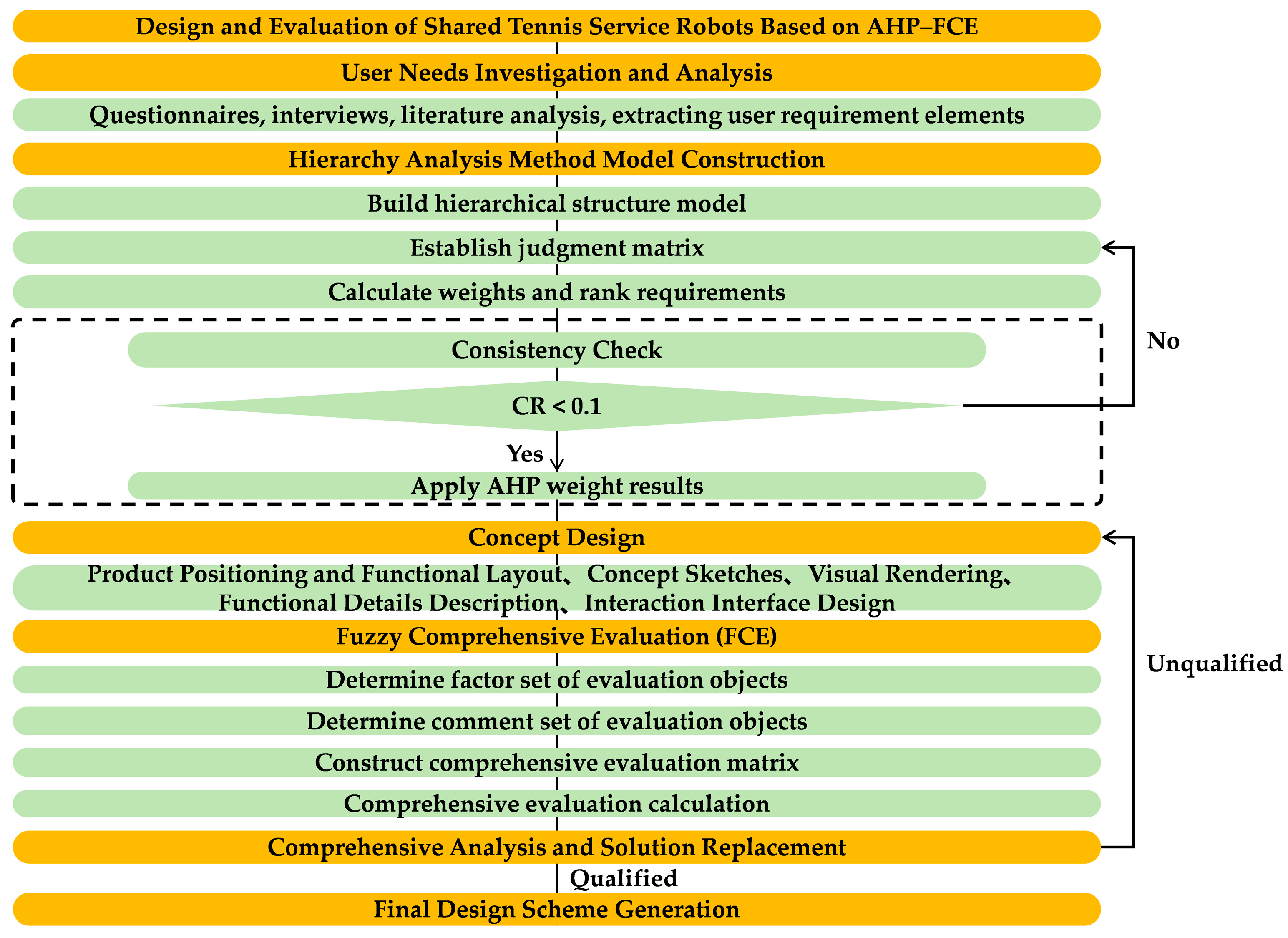
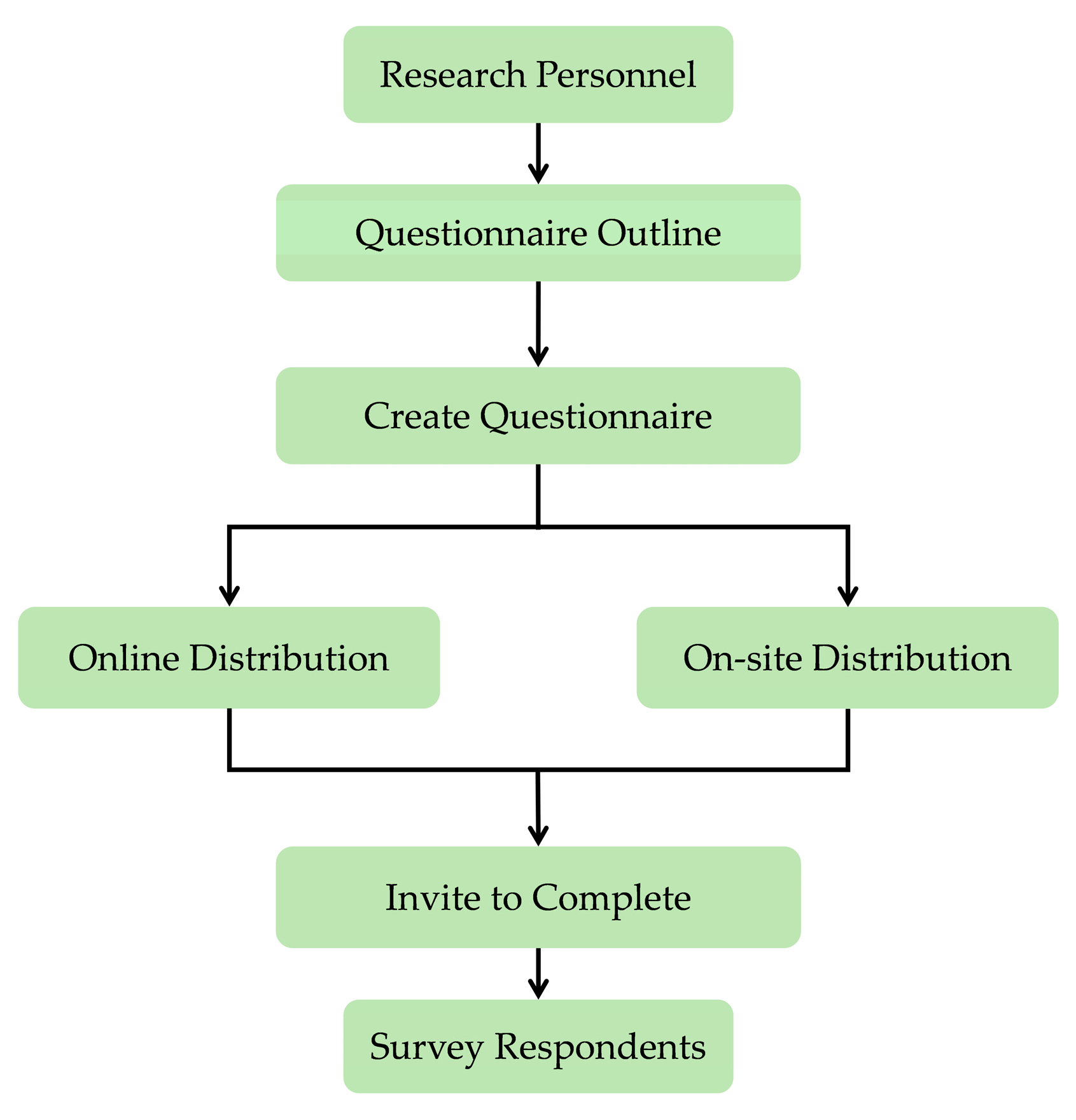
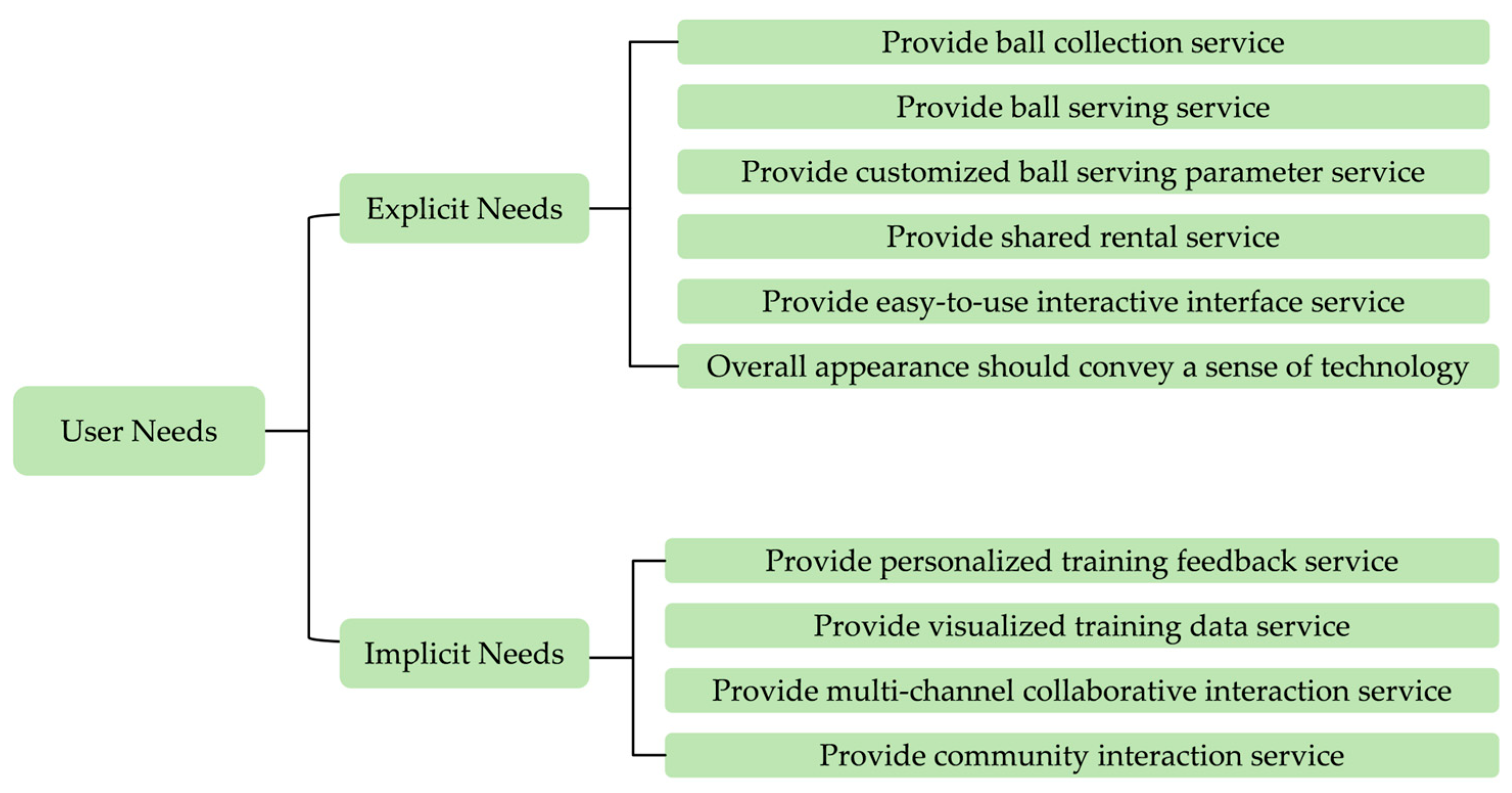




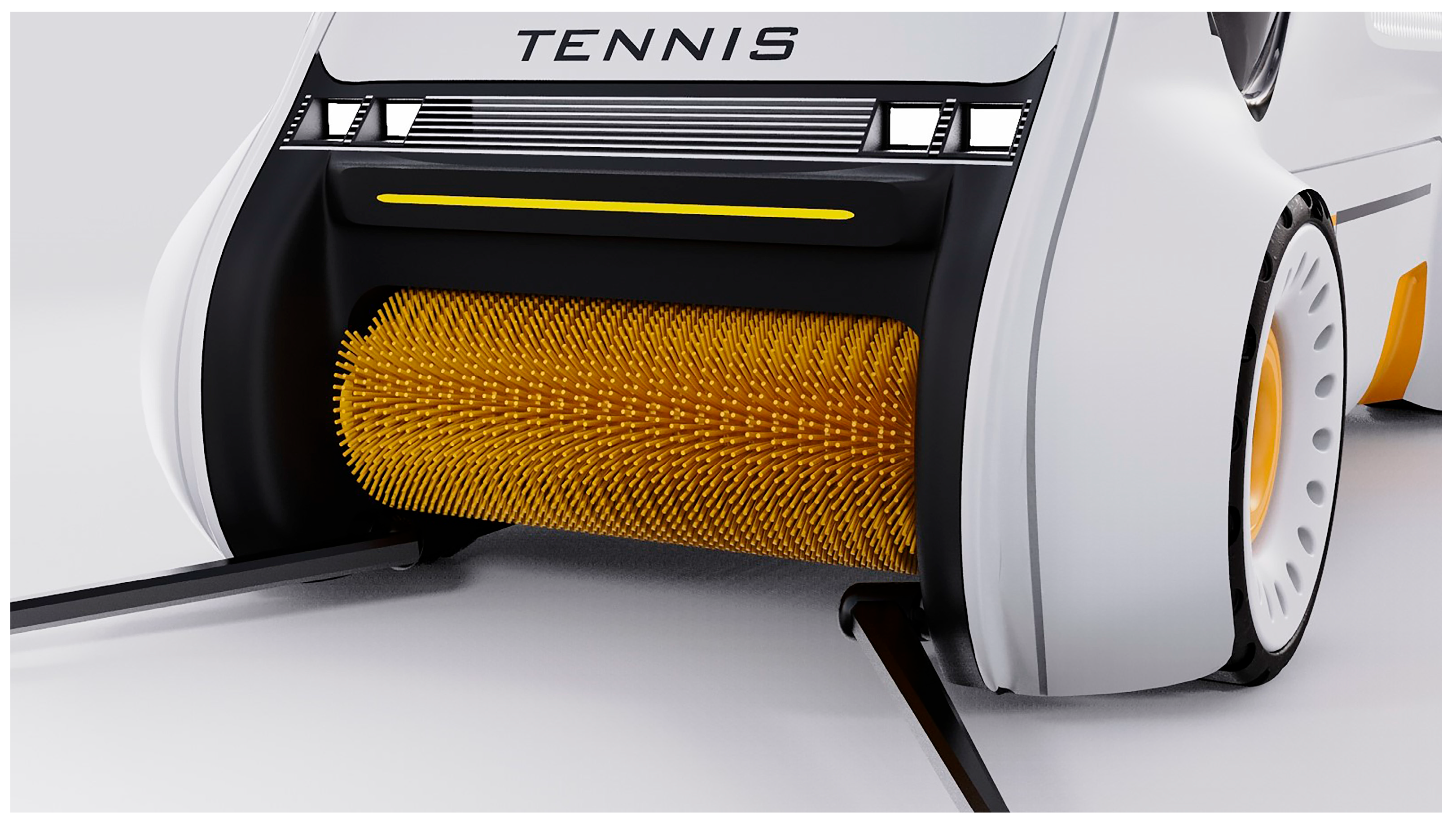
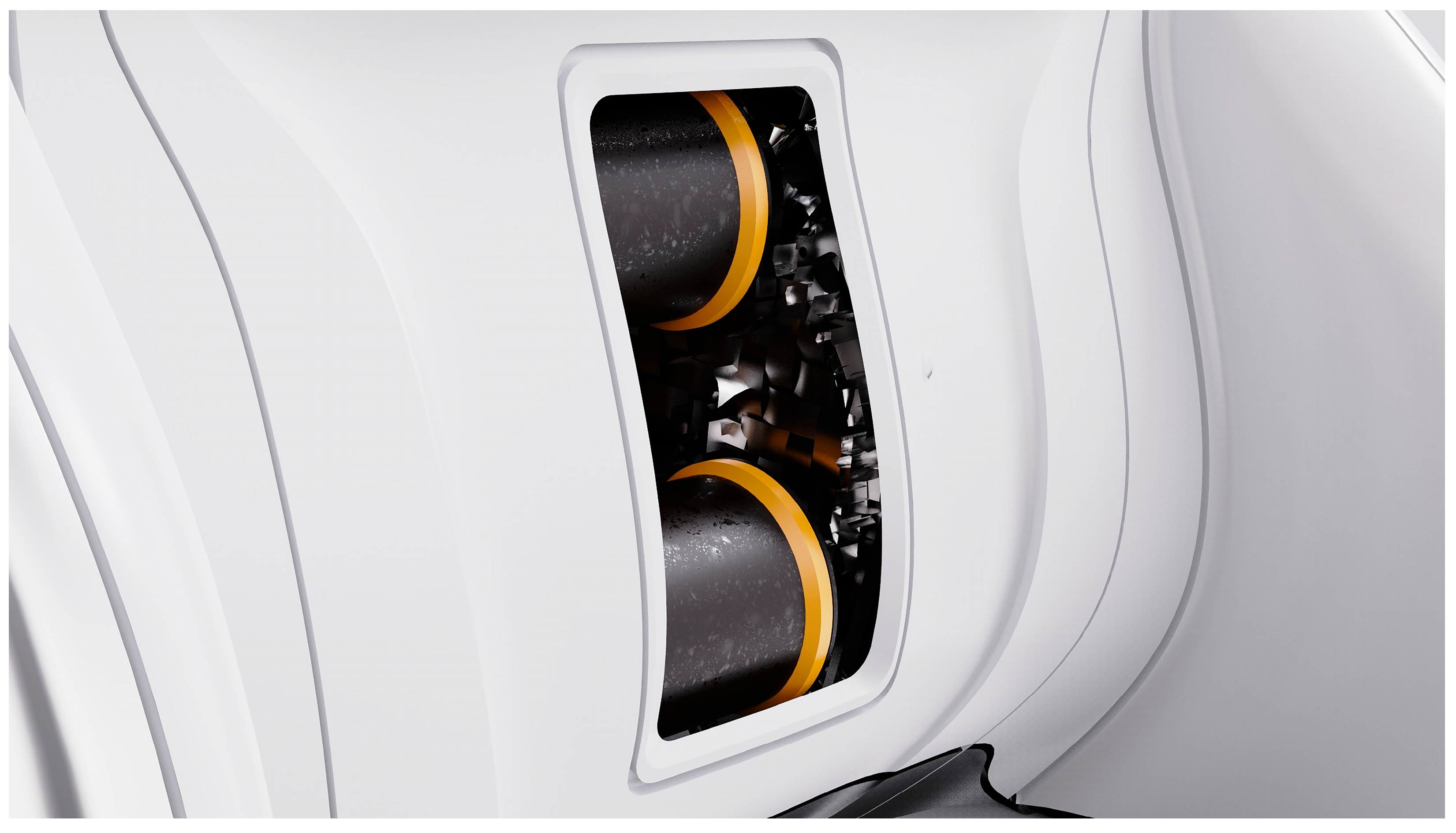
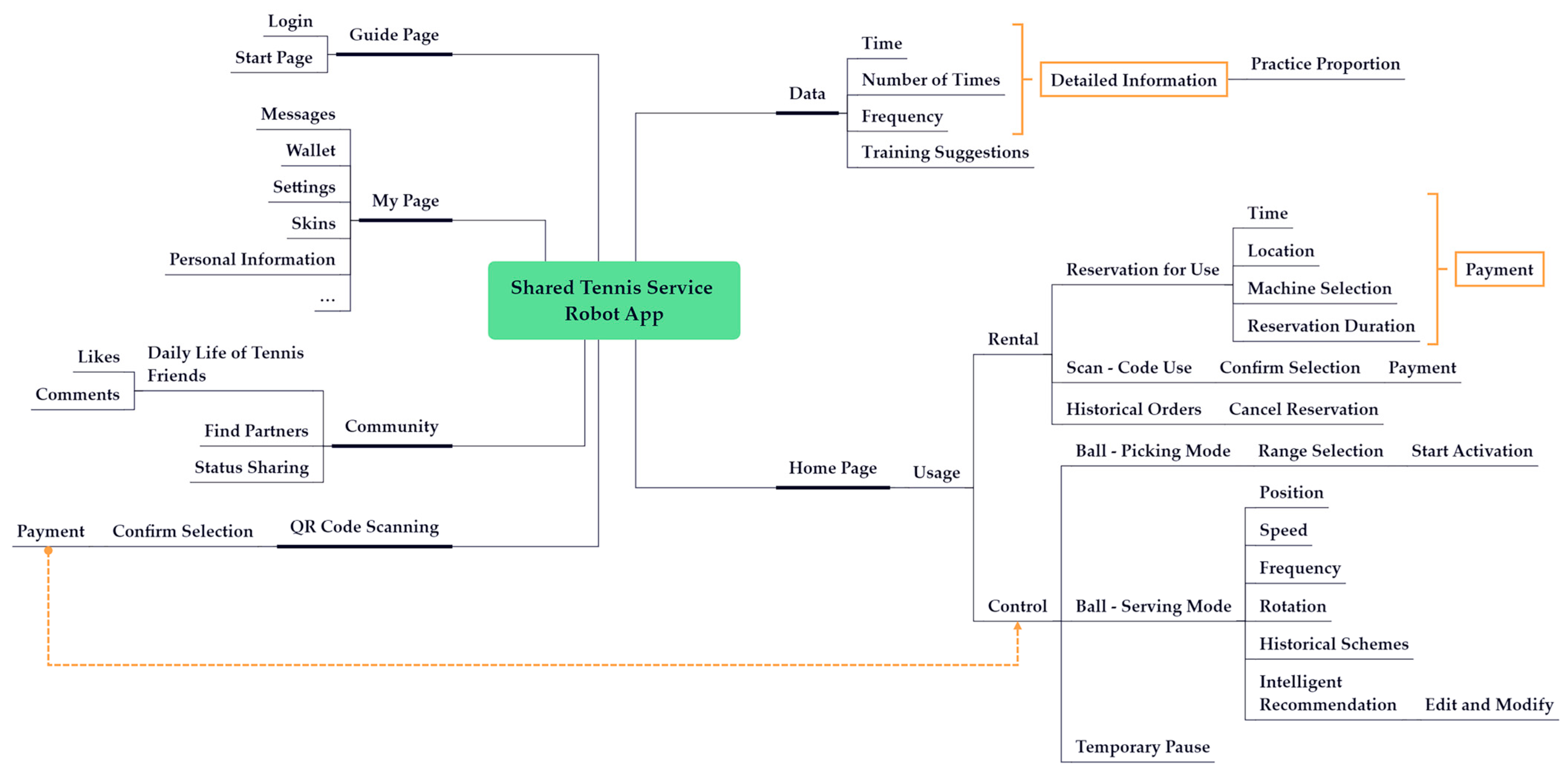


| Serial Number | Question Type | Brief Description of the Issue |
|---|---|---|
| 1 | Basic Information | Gender, age, occupation, city of residence, income |
| 2 | Behavioral Information Section | Frequency of playing on the court; Practice methods (playing with partners, using solo training aids, coaching sessions); Challenges encountered (difficulty finding playing partners, training aids being too expensive) |
| 3 | Product Experience (Serving) | Usage Status—Reasons for Non-Use, Whether Interaction Process Is Cumbersome |
| 4 | Product Experience (Ball Retrieval) | Ball retrieval time, ball retrieval method, inconveniences/shortcomings |
| 5 | Product Expectations Section | Serve Function Preferences (Adjustable/Fixed), Interaction Methods (Remote Control, Voice, App, Physical Buttons), Personalization Needs, Interaction Feature Requirements (Light Indicators, Remote Control), Esthetic Preferences (Sporty Style…), Willingness to Try Sharing, Rental Cost Range, Key Features Desired? |
| Interview Stage | Main Section | Main Issues |
|---|---|---|
| Initial stage | Personal Information | Gender, age, education level, hobbies |
| Before playing ball | Tennis Activity Status, Practice Schedule, Playing Partners Status, Ball Machine Usage Status | |
| Intermediate stage | Playing ball | Answering and making calls, dropping and picking up items, interaction feedback methods |
| After playing ball | Ball Retrieval Methods, Ball Retrieval Duration, Practice Logs, Issues with Ball Retrieval | |
| In-depth Phase | User Expectations | Basic functional requirements, interaction requirements, visual design requirements |
| Scale Level | 1 | 3 | 5 | 7 | 9 | 2, 4, 6, 8 | 1/3, 1/5, 1/7, 1/9 |
|---|---|---|---|---|---|---|---|
| Semantic Evaluation | Equally important | Slightly important | Important | Extremely important | Of paramount importance | The median value in two consecutive scales | The ratio of the importance of indicators and is denoted as . Then, the importance ratio of indicator to satisfies |
| degree | 3 | 4 | 5 | 6 | 7 | 8 | 9 | 10 |
| 0.58 | 0.89 | 1.12 | 1.24 | 1.32 | 1.41 | 1.45 | 1.49 |
| Primary User Requirements | Secondary User Requirements | Tier 3 User Requirements |
|---|---|---|
| User Requirements for Shared Tennis Service Robots | Functional Requirements | Smart Ball Retrieval Smart Serve Shared Rental Model Mobility Tennis Storage |
| Esthetic needs | Tech-inspired LED light strips Sleek design Everyday color palette | |
| Interaction Requirements | Clean interface Data visualization User-friendly operation Light indicators Voice interaction | |
| Self-actualization needs | Customized serving parameters Personalized training plans Community exchange platform |
| E1 Judgment Matrix | P1 Functional Requirements | P2 Esthetic Needs | P3 Interaction Requirements | P4 Self-Actualization Needs |
|---|---|---|---|---|
| P1 Functional Requirements | 1 | 9 | 5 | 3 |
| P2 Esthetic needs | 1/9 | 1 | 1/6 | 1/4 |
| P3 Interaction Requirements | 1/5 | 6 | 1 | 1 |
| P4 Self-actualization needs | 1/3 | 4 | 1 | 1 |
| P1 Judgment Matrix | G1 Smart Ball Retrieval | G2 Smart Serve | G3 Shared Rental Model | G4 Mobility | G5 Tennis Storage |
|---|---|---|---|---|---|
| G1 Smart Ball Retrieval | 1 | 1 | 5 | 7 | 8 |
| G2 Smart Serve | 1 | 1 | 6 | 5 | 6 |
| G3 Shared Rental Model | 1/5 | 1/6 | 1 | 3 | 2 |
| G4 Mobility | 1/7 | 1/5 | 1/3 | 1 | 4 |
| G5 Tennis Storage | 1/8 | 1/6 | 1/2 | 1/4 | 1 |
| P2 Judgment Matrix | G6 Tech-Inspired | G7 LED Light Strips | G8 Sleek Design | G9 Everyday Color Palette |
|---|---|---|---|---|
| G6 Tech-inspired | 1 | 8 | 1 | 7 |
| G7 LED light strips | 1/8 | 1 | 1/6 | 3 |
| G8 Sleek design | 1 | 6 | 1 | 6 |
| G9 Everyday color palette | 1/7 | 1/3 | 1/6 | 1 |
| P3 Judgment Matrix | G10 Clean Interface | G11 Data Visualization | G12 User-Friendly Operation | G13 Light Indicators | G14 Voice Interaction |
|---|---|---|---|---|---|
| G10 Clean interface | 1 | 1 | 4 | 3 | 7 |
| G11 Data visualization | 1 | 1 | 1/2 | 5 | 6 |
| G12 User-friendly operation | 1/4 | 2 | 1 | 3 | 4 |
| G13 Light indicators | 1/3 | 1/5 | 1/3 | 1 | 2 |
| G14 Voice interaction | 1/7 | 1/6 | 1/4 | 1/2 | 1 |
| P4 Judgment Matrix | G15 Clean Interface | G16 Data Visualization | G17 User-Friendly Operation |
|---|---|---|---|
| G15 Clean interface | 1 | 4 | 7 |
| G16 Data visualization | 1/4 | 1 | 4 |
| G17 User-friendly operation | 1/7 | 1/4 | 1 |
| P1 Judgment Matrix | G1 Smart Ball Retrieval | G2 Smart Serve | G3 Shared Rental Model | G4 Mobility | G5 Tennis Storage | Normalized Weight Index |
|---|---|---|---|---|---|---|
| G1 Smart Ball Retrieval | 1.0000 | 1.0000 | 5.0000 | 7.0000 | 8.0000 | 0.4003 |
| G2 Smart Serve | 1.0000 | 1.0000 | 6.0000 | 5.0000 | 6.0000 | 0.3722 |
| G3 Shared Rental Model | 0.2000 | 0.1667 | 1.0000 | 3.0000 | 2.0000 | 0.1009 |
| G4 Mobility | 0.1429 | 0.2000 | 0.3333 | 1.0000 | 4.0000 | 0.0830 |
| G5 Tennis Storage | 0.1250 | 0.1667 | 0.5000 | 0.2500 | 1.0000 | 0.0437 |
| Inspection Criteria | ||||||
| P2 Judgment Matrix | G6 Tech-Inspired | G7 LED Light Strips | G8 Sleek Design | G9 Everyday Color Palette | Normalized Weight Index |
|---|---|---|---|---|---|
| G6 Tech-inspired | 1.0000 | 8.0000 | 1.0000 | 7.0000 | 0.4508 |
| G7 LED light strips | 0.1250 | 1.0000 | 0.1667 | 3.0000 | 0.0921 |
| G8 Sleek design | 1.0000 | 6.0000 | 1.0000 | 6.0000 | 0.4034 |
| G9 Everyday color palette | 0.1429 | 0.3333 | 0.1667 | 1.0000 | 0.0537 |
| Inspection Criteria | |||||
| P3 Judgment Matrix | G10 Clean Interface | G11 Data Visualization | G12 User-Friendly Operation | G13 Light Indicators | G14 Voice Interaction | Normalized Weight Index |
|---|---|---|---|---|---|---|
| G10 Clean interface | 1.0000 | 1.0000 | 4.0000 | 3.0000 | 7.0000 | 0.3687 |
| G11 Data visualization | 1.0000 | 1.0000 | 0.5000 | 5.0000 | 6.0000 | 0.2756 |
| G12 User-friendly operation | 0.2500 | 2.0000 | 1.0000 | 3.0000 | 4.0000 | 0.2308 |
| G13 Light indicators | 0.3333 | 0.2000 | 0.3333 | 1.0000 | 2.0000 | 0.0806 |
| G14 Voice interaction | 0.1429 | 0.1667 | 0.2500 | 0.5000 | 1.0000 | 0.0443 |
| Inspection Criteria | ||||||
| P4 Judgment Matrix | G15 Clean Interface | G16 Data Visualization | G17 User-Friendly Operation | Normalized Weight Index |
|---|---|---|---|---|
| G15 Clean interface | 1.0000 | 4.0000 | 7.0000 | 0.6877 |
| G16 Data visualization | 0.2500 | 1.0000 | 4.0000 | 0.2344 |
| G17 User-friendly operation | 0.1429 | 0.2500 | 1.0000 | 0.0778 |
| Inspection Criteria | ||||
| Guideline Layer P | Weight Value | Sorting | Sub-Principle Level G | Weight Value | Composite Weighting | Sorting |
|---|---|---|---|---|---|---|
| Functional Requirements P1 | 0.5818 | 1 | Smart Ball Retrieval G1 | 0.4003 | 0.2329 | 1 |
| Smart Serve G2 | 0.3722 | 0.2165 | 2 | |||
| Shared Rental Model G3 | 0.1009 | 0.0587 | 5 | |||
| Mobility G4 | 0.0830 | 0.0434 | 7 | |||
| Tennis Storage G5 | 0.0437 | 0.0254 | 10 | |||
| Esthetic needs P2 | 0.0471 | 4 | Tech-inspired G6 | 0.4508 | 0.0212 | 11 |
| LED light strips G7 | 0.0921 | 0.0043 | 16 | |||
| Sleek design G8 | 0.4034 | 0.0190 | 12 | |||
| Everyday color palette G9 | 0.0537 | 0.0025 | 17 | |||
| Interaction Requirements P3 | 0.1879 | 2 | Clean interface G10 | 0.3687 | 0.0693 | 4 |
| Data visualization G11 | 0.2756 | 0.0518 | 6 | |||
| User-friendly operation G12 | 0.2308 | 0.0434 | 8 | |||
| Light indicators G13 | 0.0806 | 0.0151 | 13 | |||
| Voice interaction G14 | 0.0443 | 0.0083 | 15 | |||
| Self-actualization needs P4 | 0.1832 | 3 | Customized serving parameters G15 | 0.6877 | 0.1260 | 3 |
| Personalized training plans G16 | 0.2344 | 0.0429 | 9 | |||
| Community exchange platform G17 | 0.0778 | 0.0143 | 14 |
| Evaluation Item G | Composite Weighting | V1 Excellent | V2 Good | V3 Moderate | V4 Poor |
|---|---|---|---|---|---|
| Smart Ball Retrieval G1 | 0.2329 | 3 | 2 | 0 | 0 |
| Smart Serve G2 | 0.2165 | 3 | 2 | 0 | 0 |
| Shared Rental Model G3 | 0.0587 | 2 | 2 | 1 | 0 |
| Mobility G4 | 0.0434 | 0 | 3 | 2 | 0 |
| Tennis Storage G5 | 0.0254 | 0 | 2 | 3 | 0 |
| Tech-inspired G6 | 0.0212 | 1 | 2 | 2 | 0 |
| LED light strips G7 | 0.0043 | 0 | 2 | 2 | 0 |
| Sleek design G8 | 0.0190 | 1 | 2 | 1 | 1 |
| Everyday color palette G9 | 0.0025 | 2 | 2 | 1 | 0 |
| Clean interface G10 | 0.0693 | 3 | 2 | 0 | 0 |
| Data visualization G11 | 0.0518 | 2 | 0 | 3 | 0 |
| User-friendly operation G12 | 0.0434 | 1 | 1 | 2 | 1 |
| Light indicators G13 | 0.0151 | 1 | 1 | 2 | 1 |
| Voice interaction G14 | 0.0083 | 2 | 1 | 1 | 1 |
| Customized serving parameters G15 | 0.1260 | 5 | 0 | 0 | 0 |
| Personalized training plans G16 | 0.0429 | 1 | 1 | 3 | 0 |
| Community exchange platform G17 | 0.0143 | 2 | 0 | 2 | 1 |
Disclaimer/Publisher’s Note: The statements, opinions and data contained in all publications are solely those of the individual author(s) and contributor(s) and not of MDPI and/or the editor(s). MDPI and/or the editor(s) disclaim responsibility for any injury to people or property resulting from any ideas, methods, instructions or products referred to in the content. |
© 2025 by the authors. Licensee MDPI, Basel, Switzerland. This article is an open access article distributed under the terms and conditions of the Creative Commons Attribution (CC BY) license (https://creativecommons.org/licenses/by/4.0/).
Share and Cite
Xu, X.; Meng, P.; Zhao, M.; Li, Y.; Cai, Y.; Tang, X. Design and Evaluation of Shared Tennis Service Robots Based on AHP–FCE. Appl. Sci. 2025, 15, 11147. https://doi.org/10.3390/app152011147
Xu X, Meng P, Zhao M, Li Y, Cai Y, Tang X. Design and Evaluation of Shared Tennis Service Robots Based on AHP–FCE. Applied Sciences. 2025; 15(20):11147. https://doi.org/10.3390/app152011147
Chicago/Turabian StyleXu, Xiaoxia, Ping Meng, Miao Zhao, Yan Li, Yuannian Cai, and Xinxing Tang. 2025. "Design and Evaluation of Shared Tennis Service Robots Based on AHP–FCE" Applied Sciences 15, no. 20: 11147. https://doi.org/10.3390/app152011147
APA StyleXu, X., Meng, P., Zhao, M., Li, Y., Cai, Y., & Tang, X. (2025). Design and Evaluation of Shared Tennis Service Robots Based on AHP–FCE. Applied Sciences, 15(20), 11147. https://doi.org/10.3390/app152011147





